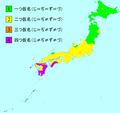Kunrei-shiki romanization (Japanese: 訓令式ローマ字, Hepburn: Kunrei-shiki rōmaji), also known as the Monbusho system (named after the endonym for the Ministry... 23 KB (2,047 words) - 01:33, 4 April 2024 |
 | Hepburn romanization (ヘボン式ローマ字, Hebon-shiki rōmaji, lit. 'Hepburn-style Roman letters') is the main system of romanization for the Japanese language. The... 48 KB (3,466 words) - 18:30, 11 April 2024 |
different romanization systems. The three main ones are Hepburn romanization, Kunrei-shiki romanization (ISO 3602) and Nihon-shiki romanization (ISO 3602... 27 KB (2,241 words) - 05:16, 24 March 2024 |
Nihon-shiki (Japanese: 日本式ローマ字, "Japan-style," romanized as Nihonsiki in the system itself) is a romanization system for transliterating the Japanese... 9 KB (630 words) - 12:18, 17 February 2024 |
1987 book Japanese: The Spoken Language. The system is based on Kunrei-shiki romanization. Japanese Yale is a less well-known alternative name for the JSL... 4 KB (506 words) - 19:12, 24 April 2024 |
mora. Both are phonemically /ti/, reflected in the Nihon-shiki and Kunrei-shiki romanization ti, although, for phonological reasons, the actual pronunciation... 10 KB (385 words) - 13:38, 6 February 2023 |
Both represent the phonemes /si/, reflected in the Nihon-shiki and Kunrei-shiki romanization si, although for phonological reasons, the actual pronunciation... 11 KB (335 words) - 17:35, 24 August 2023 |
Û (section Romanization) si in Pinyin respectively. û represents うう in both Nihon-shiki and Kunrei-shiki romanization systems. In Afrikaans, û is a punctuated form of u and a... 3 KB (315 words) - 12:22, 22 April 2024 |
Nihon-shiki and Kunrei-shiki Romanization wo, although for phonological reasons, the actual pronunciation is [o] , reflected in the Hepburn romanization o... 7 KB (432 words) - 04:44, 9 April 2024 |
mora. Both are phonemically /tɯ/, reflected in the Nihon-shiki and Kunrei-shiki Romanization tu, although for phonological reasons, the actual pronunciation... 10 KB (413 words) - 14:21, 13 November 2023 |
 | Its name means "inequality". It is also spelled hutosiki (using Kunrei-shiki romanization). Futoshiki was developed by Tamaki Seto in 2001. The puzzle is... 2 KB (273 words) - 21:10, 15 February 2024 |
Wāpuro rōmaji (redirect from Wapuro romanization) software. Many aspects of Hepburn, Kunrei and Nihon-shiki romanizations are accepted, so that both si (Kunrei/Nihon-shiki) and shi (Hepburn) resolve to し... 7 KB (793 words) - 12:49, 25 March 2024 |
Japanese-language terminology. The word is also occasionally romanized as "omorasi" in the Kunrei-shiki romanization system. In the English-speaking BDSM community... 31 KB (3,573 words) - 22:57, 22 April 2024 |
 | Fujitsubo-Machine. Unlike most romanized Japanese words and names, Noizi Ito's name uses the Kunrei-shiki romanization form. Ito is well known for her... 7 KB (793 words) - 15:24, 6 February 2024 |
 | (山, "mountain") used in Sino-Japanese compounds. In Nihon-shiki and Kunrei-shiki romanization, the name is transliterated as Huzi. Other Japanese names... 68 KB (6,061 words) - 18:10, 4 April 2024 |
Shandong Province Tu, a city in Japan. Tu is in Kunrei-shiki romanization and Tsu in Hepburn romanization is more common. (Other than Mount E this is the... 25 KB (2,834 words) - 23:41, 12 April 2024 |
title, the Japanese word for "battlefield", is written in the kunrei-shiki romanization style. In the Hepburn style, it would be written as "Senjō". The... 4 KB (365 words) - 11:10, 25 February 2024 |
surrogate for the macrons, particularly in Hawaiian and in the Kunrei-shiki romanization of Japanese, or in transcriptions of Old High German. In transcriptions... 32 KB (3,555 words) - 18:57, 11 April 2024 |
in 1917. In terms of spelling the system is a middle ground between Kunrei-shiki and Hepburn romanisations, matching the former everywhere except for... 10 KB (720 words) - 18:01, 26 February 2024 |
Chinese romanization systems. Wade–Giles I Ching and T'ai Chi Ch'üan (pinyin: Yìjīng and Tàijíquán) are two common cases in which the Pinyin romanization more... 19 KB (2,315 words) - 06:17, 9 March 2024 |
pronunciation is [ɸɯᵝ] , which is why it is romanized fu in Hepburn romanization instead of hu as in Nihon-shiki and Kunrei-shiki rōmaji (Korean 후 /hu/ creates the... 12 KB (457 words) - 00:58, 7 April 2024 |
The matter is resolved when phonemic notation of "tu" used by Kunrei-shiki romanization is applied instead. In the case of the past-tense and te forms... 26 KB (1,849 words) - 23:09, 18 February 2024 |
 | kana") are a set of four specific kana, じ, ぢ, ず, づ (in the Nihon-shiki romanization system: zi, di, zu, du), used in the Japanese writing system. They... 5 KB (408 words) - 01:52, 2 January 2024 |
Transcription of the Japanese language in Esperanto (category Romanization of Japanese) Esperantigo de vortoj el japana fonto Romanization of Japanese Hepburn romanization Kunrei-shiki romanization Baza Esperanto-lekciono por (japanaj) retmarŝantoj... 14 KB (528 words) - 12:20, 7 April 2024 |






